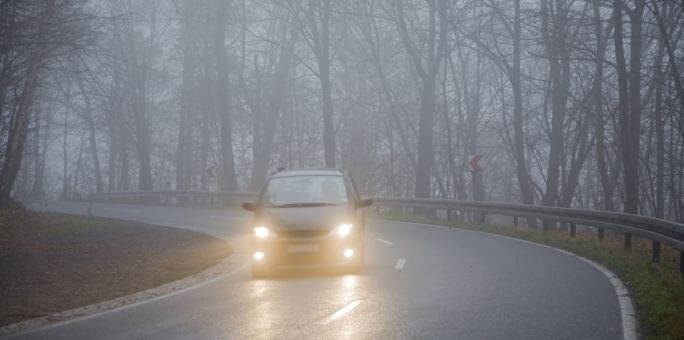Winter Driving Hazards That Aren’t Ice and Snow

The weather outside is frightful — or so the song goes — and we don’t need to tell you to be careful out there. Rain, snow and ice are road hazards we’re all familiar with, but they’re not the only insidious forces at work as you brave the winter roads. There are winter driving dangers that aren’t so obvious. The following tips may help you spot and avoid these dangers.
Visibility
I’m not talking about being able to see through blinding snowfall if you’re driving during a nor’easter (try not to do that, though). I’m talking about your ability to see the road, and other drivers’ ability to see you, on a cold, clear evening.
First, do yourself (and other drivers) a favor, and take the time to de-ice all of your windows and mirrors. Next, when is the last time you changed your headlights? Headlights don’t only need replacement with they burn out – they tend to dim over time and can impair your ability to see the road, which can be a problem in any season but a critical flaw during winter.
Finally, once you’ve got a good, bright set of headlights, use them! I don’t mean only at night, but also in twilight and anytime the weather is misty, gray or snowy. You want to make sure other drivers can see you through the gray haze that sometimes accompanies cold weather.
Battery Failure
How old is the battery in your car? If the answer is more than three years, you may want to think about replacing it. Cold weather can impair an aging battery’s ability to start your car, especially when temperatures dip below freezing. If you’re not buying a new battery, consider giving your current battery a once-over to see how it looks. Check the lead connections for corrosion and clean them as needed with a wire brush. You may consider investing in a portable power source, which can deliver the juice needed to jump-start your car should you get stranded – and, at the very least, never leave home without a set of jumper cables.
Tire Pressure
Tire pressure should be checked monthly, but this is doubly true in colder weather. Cool temperature changes air pressure, and tires with plenty of air in the summer will show less pressure in winter simply due to the change in atmospheric pressure. When inflating your tires, use the pressure indicated in your manual, or on the label inside the driver’s side door. Never use pressures indicated on the tire sidewall.
Salt
With winter comes road treatment, which usually means rock salt or a salty brine sprayed on roads. While this is very effective at keeping the roads safe from ice, salt is also quite corrosive and can damage your car’s finish if left for too long. Regular visits to the car wash are highly recommended to keep this stuff from doing too much damage. And don’t neglect the undercarriage: A lot of road muck ends up on the undercarriage, which is easy to overlook, so do your best to clean under there, too. Remember, once rust takes hold, it’s like a cancer eating at your vehicle’s body, frame and critical parts. Keep the corrosive beast at bay with diligent cleaning.
The Cold
It goes without saying that where there is snow and ice, there are freezing temperatures. And the cold isn’t just a danger to your car, it’s a danger to you. It’s an unpleasant thought, but should you become stranded in your vehicle, a couple of blankets and a car emergency kit stowed in your trunk could make all the difference. (A standard car emergency kit will probably include an emergency blanket, but some nice, downy comforters will work too.)
If you’re heading out on the road, practice good winter driving safety: Make sure others know your travel plans and route, travel with some canned food and bottled water with you in the car cabin, and remember that while they’re very handy, sometimes gadgets like cellphones and GPS fail, so try to pack a good old-fashioned road map – just in case.
We hope these tips keep you warm and safe on the roads this winter. Drive safely out there!
Source: https://al.st/2FZN4Wd

